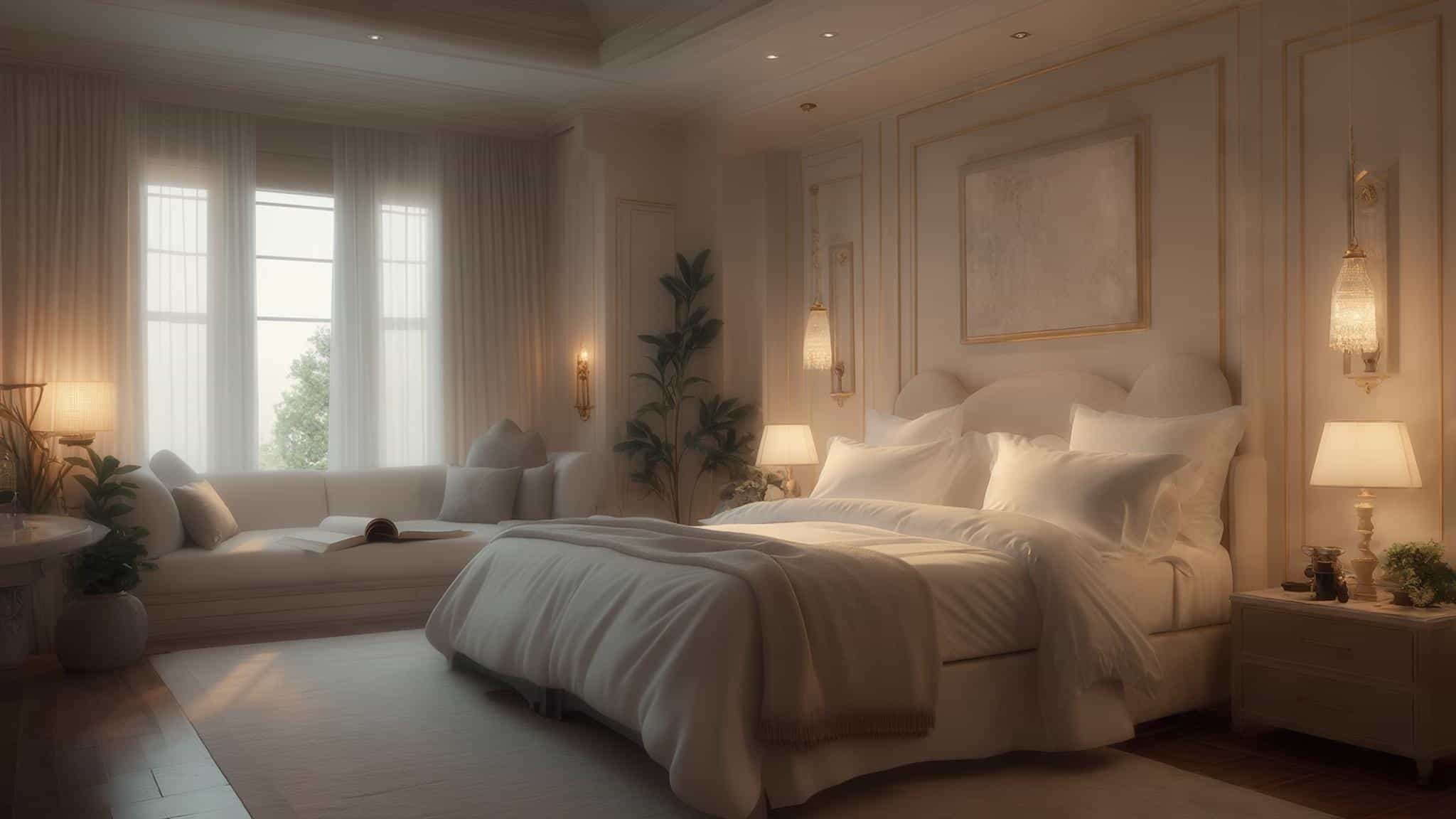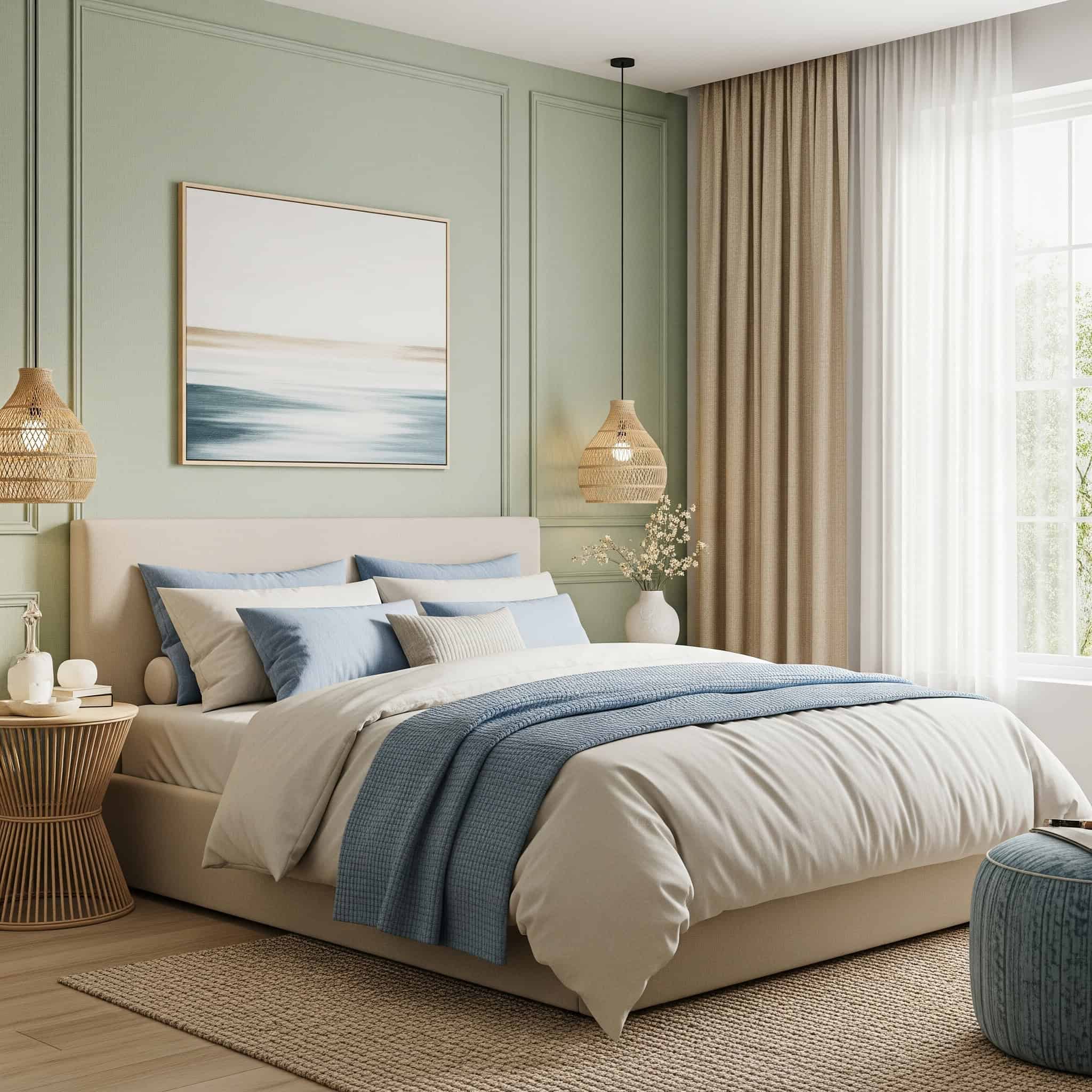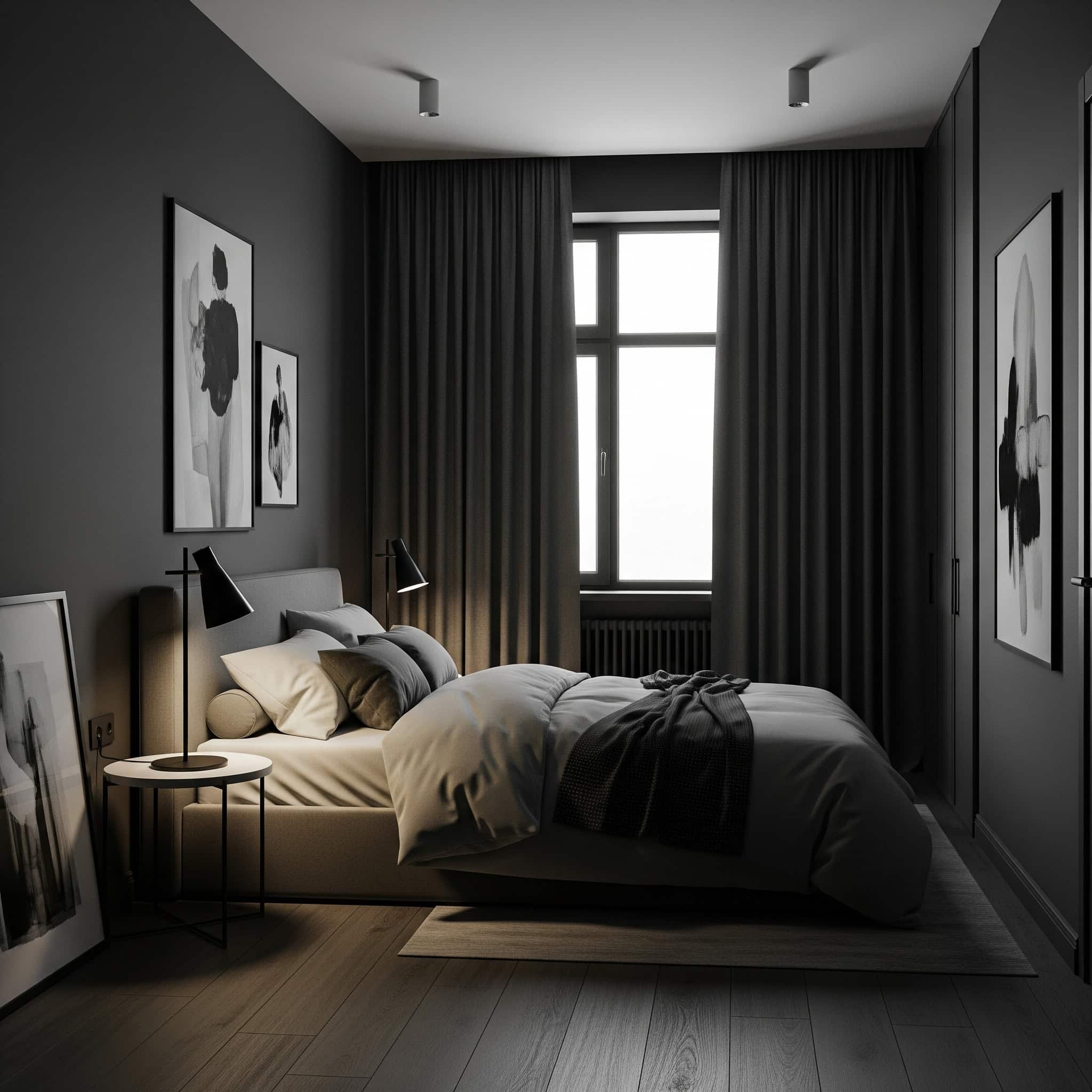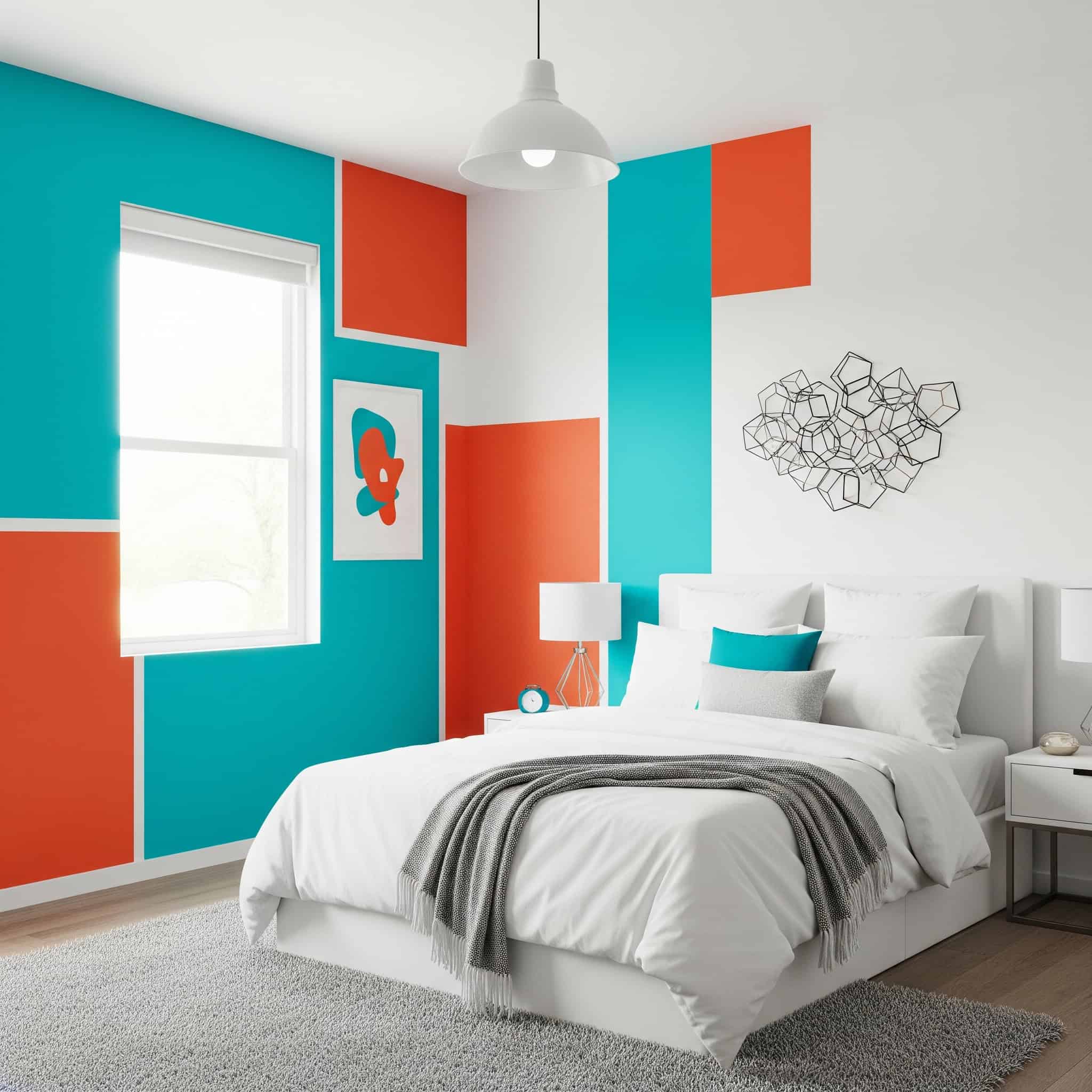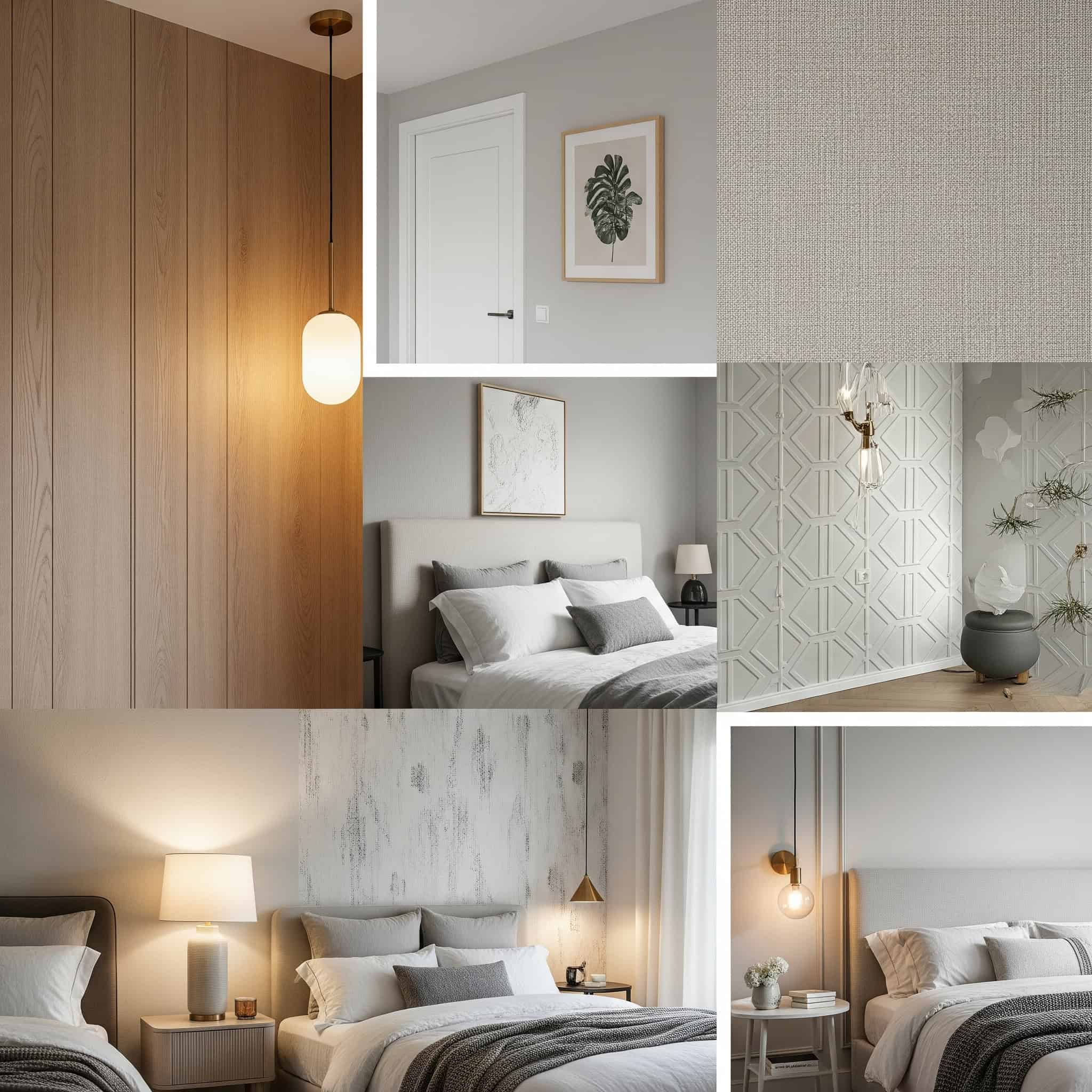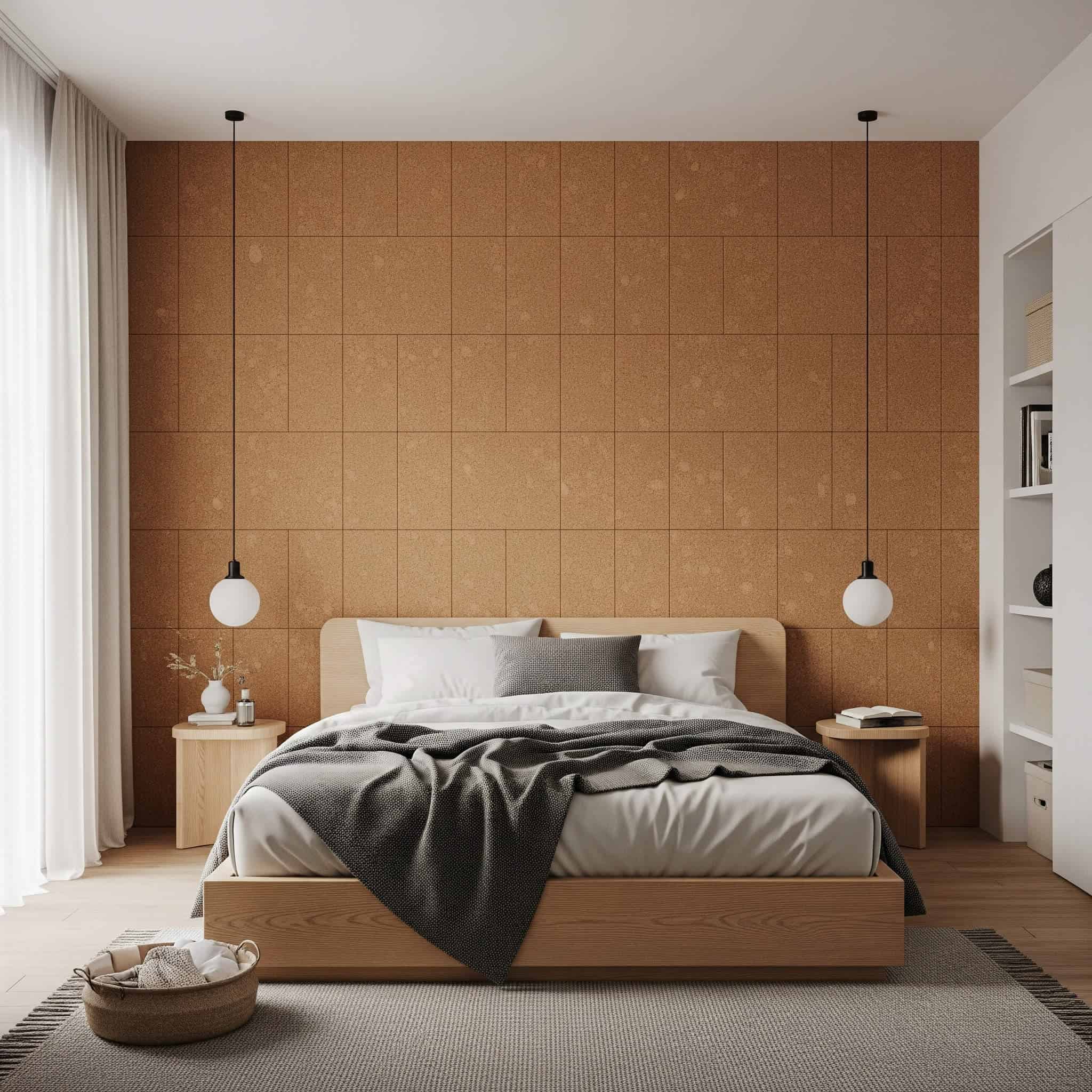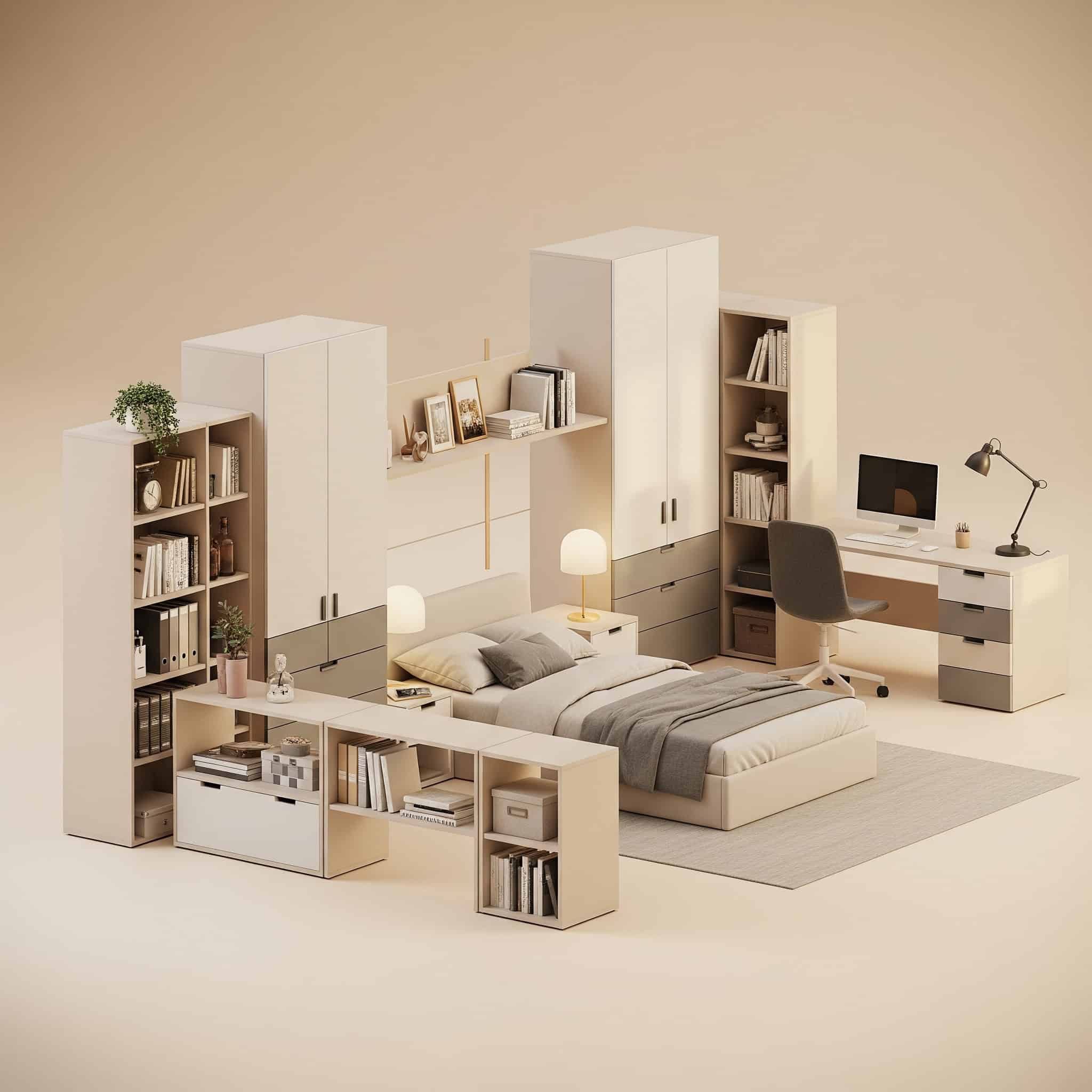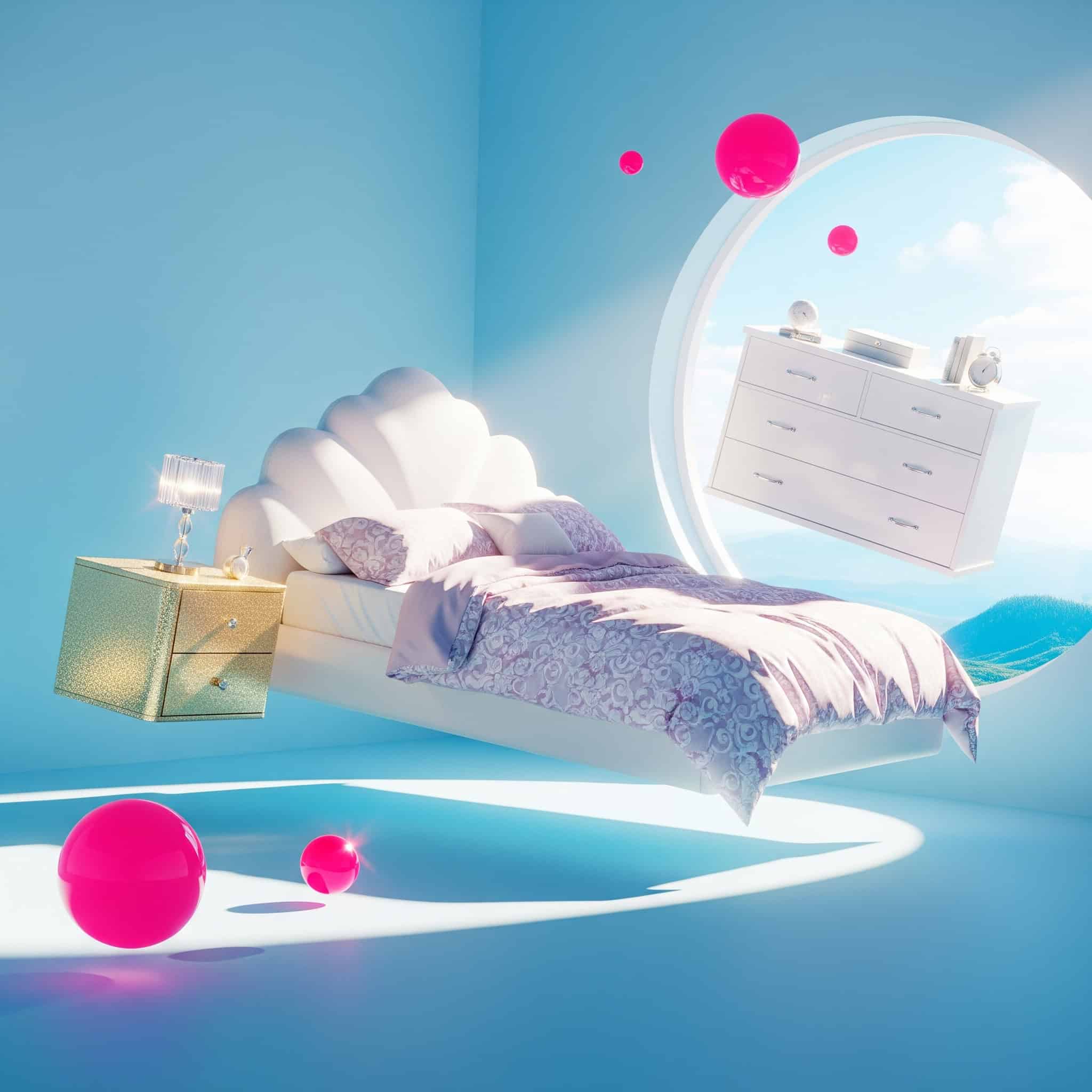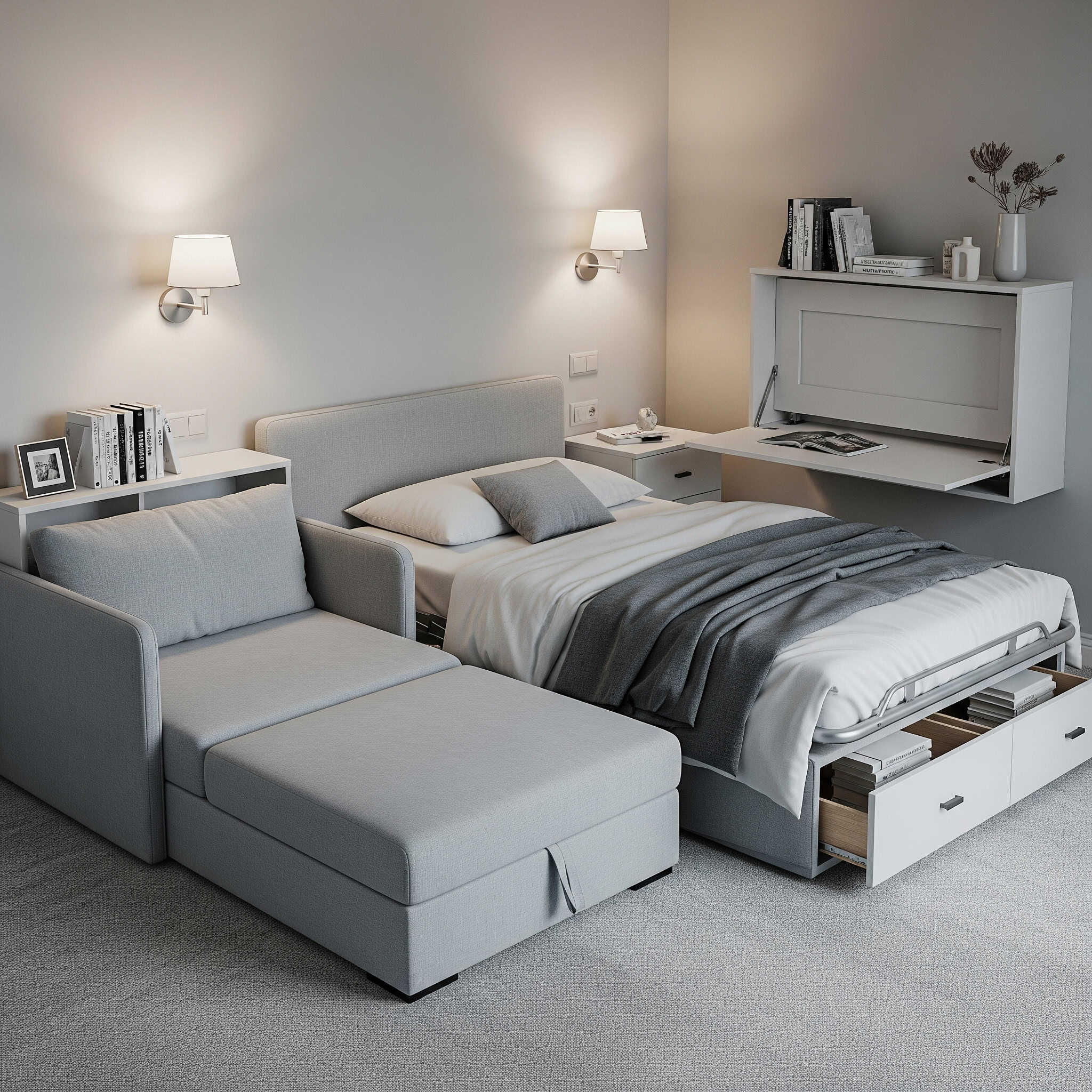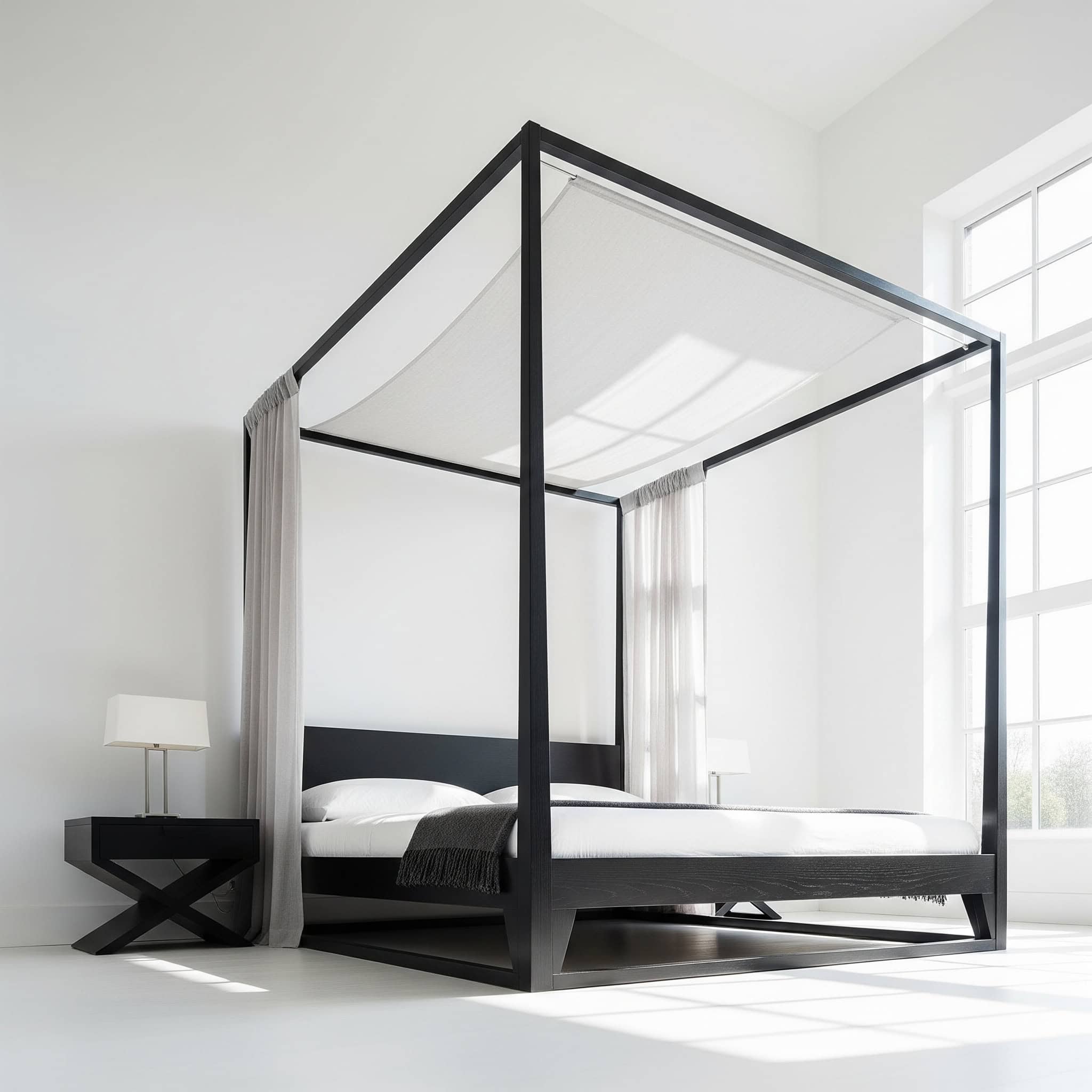25 Stunning Master Bedroom Ideas for 2025 That Will Transform Your Space
According to a recent survey by the National Association of Home Builders, 83% of homeowners consider the master bedroom their most important personal space. I’ve spent countless hours researching the latest bedroom design trends to bring you this comprehensive guide for 2025. Your master bedroom should function as more than just a place to sleep—it should be your personal sanctuary that perfectly balances style, comfort, and functionality.
When you invest in your master bedroom, you’re not just creating a beautiful space—you’re making a financially sound decision. Master bedroom renovations yield approximately 40-80% ROI when selling your home, making thoughtful design choices both personally satisfying and economically beneficial.
The importance of creating an optimal sleep environment can’t be overstated. The average American spends 33 years of their life in bed, highlighting why your bedroom design deserves careful consideration and planning.
Table of Contents
-
Essential Planning Considerations
-
Color Schemes & Wall Treatments
-
Furniture & Layout Innovations
-
Lighting & Technology Integration
-
Sustainable & Wellness Features
-
Storage & Organization Solutions
-
How Jiffy Junk Can Help With Your Bedroom Transformation
-
Final Thoughts
Essential Planning Considerations
Before diving into specific design ideas, you need to establish a solid foundation for your master bedroom project. Start by evaluating your space dimensions, identifying your functional needs, determining your design aesthetic, and setting a realistic budget. Consider how you’ll address lighting requirements, storage needs, comfort factors, sustainability goals, technology integration, and personal touches that make the space uniquely yours.
Proper planning isn’t just about aesthetics—it’s about efficiency and cost-effectiveness. When you take the time to plan thoroughly, you can reduce renovation costs by 15-20% by minimizing mid-project changes and ensuring materials are ordered correctly the first time. This upfront investment of time saves both money and frustration down the road.
The physical dimensions of your master bedroom play a crucial role in determining what’s possible. The optimal master bedroom size ranges from 200-300 square feet, with a minimum of 24 inches of walking space around furniture for proper flow. Working within these parameters helps ensure your bedroom ideas can be implemented successfully without creating a cramped or uncomfortable space.
Before finalizing your master bedroom layout, consider what items need to be removed. Our guide on furniture removal vs. donation can help you decide what pieces are worth keeping or replacing.
|
Planning Element |
Key Considerations |
Typical Timeline |
|---|---|---|
|
Space Assessment |
Measure dimensions, note architectural features, identify natural light sources |
1-2 days |
|
Functional Requirements |
Sleep quality, dressing needs, relaxation, work/reading areas |
3-5 days |
|
Design Inspiration |
Create mood boards, collect samples, prioritize elements |
1-2 weeks |
|
Budget Planning |
Allocate funds across categories (furniture, lighting, decor, labor) |
1 week |
|
Project Timeline |
Account for ordering lead times, contractor availability, seasonal factors |
2-3 weeks |
A client with a 14′ x 16′ master bedroom wanted to incorporate a small work area without compromising the room’s restful atmosphere. We solved this by creating a zoning plan that placed a compact floating desk in a previously unused corner, using a folding privacy screen to visually separate it from the sleeping area. This allowed dual functionality while maintaining the bedroom’s primary purpose as a sanctuary.
Color Schemes & Wall Treatments
1. Biophilic Color Palettes
Biophilic color schemes bring the outdoors in through nature-inspired greens paired with earthy neutrals like sand and clay. These palettes create a calming environment that promotes relaxation and wellbeing. You’ll want to balance these colors carefully and ensure your space receives adequate natural light to maximize their impact.
The science behind these color choices is compelling. Studies show nature-inspired colors can reduce stress hormones by up to 60% and improve cognitive function by 15%. This makes biophilic color schemes more than just aesthetically pleasing—they’re a practical way to improve your mental and physical health through bedroom decor.
For the most harmonious results in your bedrooms, follow the 60-30-10 rule: 60% dominant color (walls), 30% secondary color (furniture), and 10% accent color (accessories). This balanced approach prevents any single color from overwhelming the space while still creating visual interest and depth.
2. Moody Monochromatic Schemes
Monochromatic color schemes using varying shades of a single color create sophisticated, enveloping atmospheres. Deep blues from navy to midnight are particularly trending for 2025. The key to success with this approach is incorporating textural elements within the same color family to add visual depth and prevent the space from feeling flat.
Creating an effective monochromatic bedroom requires attention to detail. Monochromatic schemes work best with a minimum of 3-5 different shades within the same color family to create visual interest. Without this variation, the space can feel one-dimensional rather than rich and layered.
Lighting plays a crucial role in bringing out the nuances of a monochromatic bedroom ideas. Strategic lighting is crucial—incorporate at least 3 different light sources at varying heights to highlight textural differences. This creates shadows and highlights that reveal the subtle variations in your color palette.
3. Color-Blocking Accent Walls
Color-blocking creates visual interest without overwhelming patterns. This technique involves using complementary tones like terracotta and sage green in geometric arrangements. You’ll achieve the best results by pairing these bold wall treatments with simpler furniture to maintain visual balance in your bedroom.
Professional designers recommend limiting color blocks to 2-3 colors maximum for cohesive results. Going beyond this can create a chaotic feeling that works against the restful atmosphere you want in bedrooms. The colors you choose should complement each other while providing enough contrast to define the blocks clearly.
For proper proportion in your bedroom decorating ideas, follow the golden ratio (1:1.618) when determining the size relationship between color blocks. This mathematical principle has been used in design for centuries because it creates naturally pleasing proportions. When your color blocks follow this ratio, they’ll feel intentional and harmonious rather than random or jarring.
I’ve found that color-blocking works particularly well in bedrooms with architectural challenges. A strategically placed color block can visually correct an awkward wall or highlight a beautiful feature while drawing attention away from less desirable elements.
4. Textured Wall Treatments
Textured wall treatments add dimension without changing color. Options include fluted wood paneling, 3D wall panels, or tactile wallpapers in natural textures like grasscloth or linen. You can apply these treatments to a single wall as a focal point or throughout the room for a more immersive effect.
Beyond their aesthetic appeal, textured wall treatments can improve room acoustics by reducing echo by up to 40%, creating a quieter sleep environment. This functional benefit makes them especially valuable in bedroom decor where sound quality directly impacts sleep quality.
The installation process for these treatments requires careful consideration. Installation typically requires specialized tools and techniques—professional installation costs range from $8-25 per square foot depending on material complexity. While DIY options exist, the precision required for certain textures often justifies professional help for the best bedroom design results.
5. Sustainable Wall Finishes
Sustainable wall finishes like clay plaster in warm neutrals offer both environmental and health benefits. These natural materials regulate humidity and improve air quality while adding subtle texture to your bedroom. While they may require specialized application, the long-term benefits for both your health and the planet make them worth considering.
The performance capabilities of these materials are impressive. Natural clay plasters can absorb and release moisture, maintaining optimal humidity levels between 40-60% for better sleep quality. This natural regulation helps prevent issues like dry skin and respiratory irritation that can disrupt sleep in your master bedroom.
These finishes contain zero VOCs (volatile organic compounds), eliminating the off-gassing that can cause respiratory issues with conventional paints. This makes them ideal for bedrooms where you spend approximately one-third of your life breathing the air. The health benefits become even more significant for those with allergies or chemical sensitivities.
When planning wall treatments, consider eco-friendly options that don’t compromise indoor air quality. Learn more about sustainable practices in our article on green junk removal to understand how your material choices impact the environment.
|
Wall Treatment |
Environmental Benefits |
Health Benefits |
Maintenance Level |
Approximate Cost |
|---|---|---|---|---|
|
Clay Plaster |
Biodegradable, locally sourced |
Humidity regulation, zero VOCs |
Medium |
$8-15/sq ft |
|
Cork Wall Panels |
Renewable, carbon negative |
Sound absorption, antimicrobial |
Low |
$6-12/sq ft |
|
Reclaimed Wood |
Reduces deforestation, upcycled |
No new chemical treatments |
Medium-High |
$10-25/sq ft |
|
Natural Lime Paint |
Low carbon footprint, naturally antimicrobial |
Hypoallergenic, no off-gassing |
Low |
$5-10/sq ft |
|
Grasscloth Wallpaper |
Plant-based, biodegradable |
Improves air quality, natural texture |
Medium |
$8-20/sq ft |
Furniture & Layout Innovations
6. Modular Bedroom Systems
Modular bedroom systems offer customizable components that can be reconfigured as your needs change. These systems typically include bed frames with integrated nightstands, storage components, and headboards. While the initial investment may be higher than traditional furniture, the long-term flexibility makes them increasingly popular for 2025.
The engineering behind these systems is impressive. Modular systems typically use standardized dimensions with connection points every 4-8 inches, allowing for numerous configuration possibilities. This standardization ensures that pieces work together seamlessly even as you add or rearrange components over time in your master bedroom.
Durability is another key advantage of quality modular systems. They use engineered wood with tensile strengths of 3,000-5,000 psi, ensuring durability through multiple reconfigurations. This strength means your master bedroom furniture can withstand being taken apart and reassembled multiple times without losing structural integrity—a significant advantage over traditional furniture that deteriorates with each move.
7. Floating Furniture Arrangements
Wall-mounted nightstands and dressers create visual lightness by keeping floor space visible. This approach works particularly well in smaller bedrooms or with minimalist aesthetics. You’ll need to ensure proper wall reinforcement during installation, but the benefits include easier cleaning and a more spacious feel.
The technical requirements for floating furniture deserve careful attention. Floating furniture requires wall anchors rated for 2-3 times the anticipated weight load—typically 75-150 pounds per anchor point. This safety margin ensures your furniture remains securely attached even when fully loaded with items.
Proper installation into wall studs or using toggle bolts in drywall can support up to 300 pounds when distributed across multiple mounting points. This load capacity makes floating furniture suitable for most bedrooms storage needs while creating a distinctive design element. The visual effect of floating furniture can dramatically transform how spacious your bedroom design feels, even without changing the room’s dimensions.
8. Multifunctional Furniture Pieces
Maximize functionality in limited space with multifunctional furniture like ottoman beds with storage underneath, headboards with built-in charging stations, or nightstands that convert to desks. These pieces reduce the need for additional furniture while maintaining style and comfort in your bedroom.
The storage capacity of these pieces is often surprising. Hydraulic storage beds can provide 15-30 cubic feet of hidden storage space, equivalent to a standard closet. This significant increase in storage without additional floor space makes multifunctional furniture particularly valuable in urban apartments or smaller bedroom ideas.
Technology integration requires thoughtful planning. Smart furniture with integrated technology typically requires access to power sources within 6-12 inches of installation points. When planning your bedroom decor, consider how you’ll route power cables discreetly to maintain a clean aesthetic while providing the functionality you need.
A young professional living in a 600 sq ft urban apartment transformed her bedroom by installing a queen-sized wall bed with an integrated desk system. During the day, the bed folds up to reveal a fully functional workspace with built-in shelving and cable management. At night, the desk components automatically reset when the bed is lowered. This solution saved approximately 30 square feet of floor space while providing both quality sleeping and working environments in the same room.
9. Statement Canopy Beds
Modern four-poster beds with clean lines and mixed materials create striking focal points in 2025 bedrooms. Whether you choose minimalist canopies with sheer fabric panels or more substantial structures combining wood and metal, these beds add vertical interest to your space. Ensure you have sufficient ceiling height (ideally 9 feet or more) for the best effect.
Architectural considerations are important when incorporating canopy beds. Contemporary canopy beds typically require a minimum ceiling height of 8 feet, with 10-12 feet being ideal for proper proportion. Without adequate height, the bed can feel cramped rather than grand and may dominate the master bedroom in an uncomfortable way.
The construction quality of these statement pieces significantly impacts their longevity. Frame construction using mortise and tenon joints provides 50-100% greater stability than standard bolt-together frames. This traditional joinery technique creates bedrooms that feel solid and substantial while eliminating the squeaks and wobbles that can develop in less well-constructed beds over time.
10. Curved and Organic Furniture Forms
Curved headboards, rounded nightstands, and organically shaped seating create a more relaxed atmosphere in your bedroom. These softer forms contrast beautifully with architectural angles and straight lines. You’ll need thoughtful space planning since curved pieces often require more room than their rectangular counterparts.
The spatial requirements of curved furniture deserve consideration. Curved furniture typically requires 10-15% more floor space than rectangular pieces with equivalent functionality. This additional space requirement needs to be factored into your bedroom design to ensure proper circulation and prevent a crowded feeling.
Modern manufacturing techniques have made curved furniture more accessible and durable. Manufacturing techniques like steam bending and five-axis CNC routing allow for curves with structural integrity equal to straight components. These advances mean curved furniture can be both beautiful and long-lasting, making it a worthwhile investment for your bedroom decor.
When upgrading to new furniture styles, you’ll need a plan for your old pieces. Check out our furniture removal guide for tips on responsibly disposing of unwanted bedroom furniture when refreshing your space.
Lighting & Technology Integration
11. Smart Lighting Systems
Programmable LED lighting that adjusts color temperature throughout the day supports your natural circadian rhythms. These systems, controllable via smartphone or voice commands, enhance sleep quality and offer convenience. You should consider backup controls and possibly professional installation for optimal results.
The technical capabilities of these systems are impressive. Smart lighting systems can shift from energizing daylight (5000-6500K) in morning to sleep-promoting warm light (2700-3000K) in evening. This automatic adjustment mimics natural daylight patterns, helping regulate your body’s production of melatonin and other hormones that control sleep and wakefulness.
Connectivity considerations are important for reliable operation in bedrooms. Whole-room systems typically require a central hub operating on Zigbee, Z-Wave, or Matter protocols for reliable communication between components. This infrastructure ensures your bedroom ideas involving smart lighting work consistently without frustrating connectivity issues or the need for constant troubleshooting.
12. Integrated Hidden Technology
Maintain clean aesthetics while providing functionality through hidden technology like mirrors with built-in screens, charging surfaces integrated into nightstands, or speakers concealed within wall treatments. While these solutions typically come at a higher cost, they preserve the serene atmosphere essential for a restful bedroom.
The technical requirements for these integrations are substantial. Hidden technology integration often requires custom wiring with low-voltage systems (12-24V) running behind walls or within furniture. This infrastructure needs to be planned early in your master bedroom renovation to avoid costly modifications later.
The sophistication of these systems continues to advance. Smart mirrors typically incorporate IP65 water-resistant displays with capacitive touch sensors that function through 4-6mm of glass. This technology allows for seamless integration of digital displays into what appears to be an ordinary mirror, maintaining the clean aesthetic of your master bedroom while providing access to information, entertainment, or smart home controls.
13. Statement Pendant Lighting
Oversized sculptural pendants or clusters of smaller fixtures suspended over nightstands free up surface space while creating visual interest. This approach requires proper ceiling support and benefits from dimming capabilities for flexibility. You’ll want to hang these fixtures at the right height—typically 28-36 inches above your nightstand surface.
The structural requirements for pendant lighting deserve attention. Pendant fixtures should be mounted with junction boxes rated for the fixture weight plus 25% safety margin. This safety factor ensures your beautiful lighting remains securely attached to the ceiling even if the fixture is heavier than anticipated or experiences vibration.
Light output needs to be carefully calculated for bedrooms. For optimal task lighting, pendants should provide 75-100 lumens per square foot of surface area being illuminated. This ensures sufficient light for reading or other activities while avoiding harsh glare that can disrupt the relaxing atmosphere you want in your bedroom decor.
14. Layered Ambient Lighting
Create atmosphere and depth with multiple light sources like recessed perimeter lighting combined with cove lighting along architectural features. This multi-dimensional approach requires planning during construction or renovation but results in a highly customizable environment. Zoned controls allow you to activate different lighting scenarios based on your needs.
The technical specifications for effective layered lighting are precise. Professional lighting designers recommend 5-7 lumens per square foot for ambient lighting, 30-50 lumens for task areas. This significant difference highlights why a single overhead light source rarely provides adequate illumination for all bedroom ideas and activities.
The electrical infrastructure needed is more complex than traditional lighting. Layered lighting systems typically require 3-4 separate circuits with dedicated dimmers or smart controls for maximum flexibility. This infrastructure allows you to create different moods and functional zones within your bedroom decor without compromising on either atmosphere or practicality.
15. Wellness-Focused Lighting
Support your health and wellbeing with full-spectrum lighting systems that mimic natural daylight, including evening modes that reduce blue light before sleep. While these systems require a higher initial investment, their positive impact on sleep quality and overall health makes them increasingly popular for 2025 bedroom designs.
The technical specifications of these systems are impressive. Wellness lighting systems use LEDs with CRI (Color Rendering Index) ratings of 95+ to accurately reproduce natural light spectrum. This high color accuracy ensures that colors appear true to life, which has both aesthetic and psychological benefits in your master bedroom.
The programming capabilities continue to advance. Advanced systems incorporate automatic time-based programming that gradually shifts color temperature by 100-200K per hour to match natural daylight patterns. This subtle transition is barely perceptible in the moment but helps maintain your circadian rhythm throughout the day and prepares your body for sleep in the bedrooms.
|
Lighting Type |
Primary Function |
Ideal Placement |
Color Temperature |
Control Type |
|---|---|---|---|---|
|
Task Lighting |
Reading, dressing |
Bedside, closets, vanity |
3000-4000K |
Individual switches/dimmers |
|
Ambient Lighting |
Overall illumination |
Ceiling, wall sconces |
2700-3500K |
Smart controls/scenes |
|
Accent Lighting |
Highlighting features |
Art, architectural elements |
2700-3000K |
Separate circuit, dimmable |
|
Circadian Lighting |
Sleep cycle support |
Throughout room |
Variable (2000-6500K) |
Automated/programmable |
|
Night Lighting |
Safe navigation |
Pathway to bathroom, closet |
1800-2200K (amber) |
Motion sensors, very dim |
Sustainable & Wellness Features
16. Eco-Friendly Material Selection
Reduce environmental impact while improving indoor air quality through thoughtful material choices. Opt for beds made from FSC-certified wood, organic cotton bedding, natural fiber rugs, and VOC-free finishes. You’ll need to research carefully to avoid greenwashing, but the benefits for both your health and the planet are substantial.
Verification of environmental claims is essential. Truly sustainable materials should have third-party certifications like FSC, GOTS, or Greenguard Gold to verify environmental claims. These certifications provide assurance that the bedroom decor products you’re choosing actually deliver on their environmental promises rather than just using eco-friendly marketing language.
The environmental impact differences between material choices can be dramatic. Natural materials typically have 50-90% lower carbon footprints than synthetic alternatives when accounting for full lifecycle impacts. This significant difference means your master bedroom material choices can substantially reduce your environmental footprint while creating a healthier sleep environment.
17. Indoor Plants as Design Elements
Strategic placement of air-purifying plants like snake plants or peace lilies improves air quality while adding life and color to your bedroom. Consider vertical gardens or using plants as room dividers for maximum impact. You’ll need to select species appropriate for your bedroom’s light conditions and establish a maintenance routine.
The air-purifying capabilities of plants are backed by science. NASA research shows certain houseplants can remove up to 87% of air toxins within 24 hours in enclosed spaces. This remarkable cleaning ability makes plants functional as well as beautiful additions to bedrooms where air quality directly impacts sleep quality.
For maximum benefit, quantity matters. For optimal air purification, incorporate 1-2 medium-sized plants (10-12″ pots) per 100 square feet of bedroom space. This density provides sufficient leaf surface area to meaningfully impact air quality while creating a visually pleasing distribution of plants throughout your bedrooms.
I’ve found that even people who don’t consider themselves to have a green thumb can successfully maintain certain low-maintenance plants like ZZ plants or pothos in their bedrooms. These hardy species thrive with minimal care while still providing air-purifying benefits.
18. Natural Ventilation Optimization
Reduce energy consumption and improve air quality through strategically placed windows with automated controls, ceiling fans with DC motors, or passive cooling systems. These approaches may require architectural modifications but pay dividends in comfort and energy savings. You’ll want to consider your local climate and seasonal changes when planning.
The technical requirements for effective natural ventilation are specific. Cross-ventilation requires window placement on opposite or adjacent walls with a minimum separation of 8 feet for effective airflow. This configuration creates pressure differentials that drive air movement through your master bedroom without mechanical assistance.
Energy efficiency improvements can be substantial. DC motor ceiling fans consume 70% less electricity than AC motors while operating 35% more quietly. This combination of energy savings and noise reduction makes DC fans ideal for bedroom design where both efficiency and a peaceful environment are priorities.
When planning your bedroom’s ventilation system, consider how air quality affects overall wellness. Our article on detecting and controlling pests and dust provides valuable insights on maintaining healthy indoor environments.
19. Sleep-Enhancing Room Design
Directly impact your sleep quality through blackout window treatments, sound-absorbing wall panels, and temperature-regulating bedding materials. Taking an integrated approach to sleep optimization yields the best results. You’ll experience improved rest and overall wellbeing when your bedroom environment supports healthy sleep patterns.
Temperature control is a critical factor in sleep quality. Optimal sleep environments maintain temperatures between 65-68°F (18-20°C) with humidity levels of 40-60%. These specific conditions support your body’s natural temperature drop during sleep and prevent discomfort from either excessive dryness or humidity that can disrupt your rest.
Sound management requires technical solutions. Acoustic treatments should target a noise reduction coefficient (NRC) of 0.7 or higher to effectively dampen sound reflections. This level of sound absorption significantly reduces noise that can trigger stress responses or wake you during lighter sleep cycles, making it an important consideration for bedroom ideas focused on wellness.
A client suffering from chronic insomnia worked with our design team to create a comprehensive sleep sanctuary. We installed triple-layer window treatments (sheer privacy layer, light-filtering day shade, and blackout liner), acoustic wall panels behind the headboard, and a smart thermostat programmed to gradually lower room temperature in the evening. The ceiling was painted in a deep navy blue to enhance the feeling of nighttime, while a white noise machine was integrated into the bedside table. Within three weeks of implementation, the client reported falling asleep 45 minutes faster and experiencing 60% fewer nighttime awakenings.
20. Biophilic Design Elements
Connect with nature through natural materials like stone and wood, nature-inspired patterns, views to outdoors, and water features. These elements reduce stress and create multi-sensory experiences that enhance wellbeing. You can incorporate biophilic design at various budget levels, from simple plant additions to more substantial architectural features.
The physiological benefits of biophilic design are measurable. Research shows biophilic design elements can reduce cortisol levels by up to 60% and increase productivity by 15%. These significant health impacts make biophilic design more than just an aesthetic choice—it’s a functional approach to creating bedrooms that support both physical and mental wellbeing.
For maximum effectiveness, diversity of natural elements matters. Most effective biophilic designs incorporate at least 7 distinct natural elements or patterns within the visual field. This variety creates a richer sensory experience that more fully replicates the complexity of natural environments, enhancing the restorative effects of your bedrooms.
I’ve seen remarkable transformations in how people feel in their bedrooms after incorporating even modest biophilic elements. Something as simple as replacing synthetic materials with natural ones or adding a small tabletop fountain can create a noticeable shift in the room’s atmosphere and how restful it feels.
Storage & Organization Solutions
21. Custom Closet Systems
Maximize storage efficiency with personalized components including adjustable shelving, specialized drawers for accessories, and illuminated hanging sections. While custom closets represent a significant investment, they add home value and dramatically improve functionality. You’ll benefit from working with a professional designer to optimize your specific storage needs.
The design principles behind effective closet systems are precise. Professional closet systems typically allocate space based on the 80/20 rule: 80% of wear comes from 20% of clothing items. This principle helps prioritize accessibility for frequently used items while still accommodating seasonal or special occasion pieces in your master bedroom.
Dimensional standards ensure proper functionality. Optimal hanging rod heights are 42″ for shirts, 84″ for dresses, with 12-14″ depth for standard clothing and 24″ for outerwear. These specific measurements create efficient storage that maximizes capacity while keeping items accessible and preventing wrinkles or damage to your clothing.
22. Hidden Storage Solutions
Maintain clean aesthetics while maximizing space utilization through storage integrated into architectural elements. Options include window seats with drawers, headboards with concealed compartments, or under-bed systems. These solutions require careful planning for accessibility but preserve the serene atmosphere essential for a restful bedroom.
The hardware quality is crucial for long-term satisfaction. Hidden storage mechanisms typically use soft-close hardware rated for 50,000+ cycles to ensure long-term reliability. This durability specification means your storage will continue to function smoothly for decades even with daily use in your bedrooms.
Proper clearances are essential for smooth operation. Effective hidden storage requires clearances of 1.5-2″ around moving components to prevent binding or damage. These precise tolerances highlight why professional design and installation often yield better results for complex hidden storage bedroom ideas than DIY approaches.
23. Open Storage as Design Feature
Create personal character through curated open shelving for displaying meaningful objects, books, and art. This approach works best when used selectively rather than for all storage needs. You might incorporate integrated lighting to highlight collections and create visual interest in your bedroom.
Engineering considerations are important for successful implementation. Display shelving should be engineered for specific load capacities—typically 30-50 pounds per linear foot for books, 15-25 pounds for decorative items. These load ratings ensure your shelving remains stable and doesn’t sag over time, maintaining both safety and aesthetics in your bedroom decor.
Lighting dramatically enhances the impact of displayed items. Optimal display lighting uses LED sources with 90+ CRI at 2700-3000K color temperature positioned at 30-45° angles. This specific lighting approach highlights textures and colors accurately while creating subtle shadows that add dimension to your displayed objects.
Open storage requires a commitment to curation and maintenance. The most successful bedroom decor implementations maintain a balance between personal expression and visual calm, with regular editing to prevent cluttered appearances that can undermine the restful quality of your master bedroom.
24. Wardrobe Room Dividers
Add functionality without permanent construction using freestanding wardrobe systems that double as room dividers. This approach creates distinct zones in larger master bedrooms while providing valuable storage space. You’ll need careful planning for access and circulation to ensure the dividers enhance rather than impede your use of the space.
Stability considerations are paramount for safety. Freestanding dividers should maintain a minimum 2:1 height-to-depth ratio for stability, with additional anchoring for units over 7 feet tall. This engineering principle ensures your divider won’t tip over, even when fully loaded with clothing or other items.
Proper air circulation prevents moisture and odor issues. For proper air circulation, dividers should stop 12-18″ below ceiling height and maintain 24-36″ clearance from HVAC vents. These clearances allow air to flow freely throughout your bedrooms, preventing stagnant areas that could lead to mildew or musty odors.
25. Minimalist Organization Systems
Create calm, uncluttered atmospheres through streamlined storage with clean lines, hidden hardware, and uniform containers. These systems often utilize vertical space for efficiency and require disciplined organization habits. You’ll benefit from regular purging of unnecessary items to maintain the minimalist aesthetic.
The organizational philosophy behind these systems is as important as their physical design. Effective minimalist systems typically incorporate the “one in, one out” principle to prevent accumulation of excess items. This discipline ensures your bedroom decor remains intentional rather than becoming cluttered over time.
Space efficiency improvements can be dramatic. Vertical storage can increase capacity by 40-60% compared to traditional horizontal arrangements in the same footprint. This significant improvement makes minimalist systems particularly valuable for smaller bedrooms or those with limited closet space.
Have you considered how a minimalist approach might change your relationship with your possessions? Many people find that streamlining their bedroom ideas to focus on quality over quantity creates not just a more beautiful space but also reduces decision fatigue and morning stress.
How Jiffy Junk Can Help With Your Bedroom Transformation
Creating your dream master bedroom often begins with clearing out the old. Jiffy Junk’s specialized residential removal services make this process seamless and environmentally responsible. Their team handles all the heavy lifting—from old mattresses and furniture to renovation debris—leaving you with a clean slate. Their commitment to sustainability means your old items might find new life through donations and recycling before anything goes to a landfill.
The comprehensive nature of their services eliminates hassle during your renovation. Jiffy Junk’s White Glove service includes complete removal, cleaning of the vacated area, and proper disposal following EPA guidelines. This thorough approach means you don’t have to worry about cleanup or finding appropriate disposal methods for different materials—they handle everything.
Their environmental commitment aligns with modern master bedroom design priorities. Their eco-friendly approach diverts up to 60% of collected materials from landfills through strategic partnerships with donation centers and recycling facilities. This responsible handling ensures your bedroom design project doesn’t come at the expense of environmental sustainability.
When undertaking a major bedroom renovation, proper disposal of old furniture is essential. Learn about environmentally responsible options in our article on how to dispose of furniture without filling landfills to make your bedroom transformation as eco-friendly as possible.
Final Thoughts
Your master bedroom should ultimately reflect your personal needs and aesthetic preferences while balancing beauty with functionality. Start your transformation with elements that will most impact your quality of life—whether improving storage, enhancing sleep quality, or creating a more visually pleasing environment. By combining thoughtful design planning with efficient removal of unwanted items, you can create the personal sanctuary you deserve.
The planning phase deserves significant attention. Successful bedroom renovations typically follow the 70/30 rule: 70% planning, 30% execution. This emphasis on upfront planning reduces costly mistakes and ensures your vision can be implemented efficiently once work begins.
A truly exceptional bedroom addresses all aspects of human experience. The most effective bedroom decor designs address all five senses: visual aesthetics, tactile comfort, acoustic quality, air quality (smell), and even taste through adjacent spaces like morning coffee stations. This holistic approach creates spaces that feel deeply satisfying on multiple levels.
For more insights on creating a clutter-free environment in your bedroom, check out our comprehensive decluttering guide to help maintain your newly designed space for years to come.
